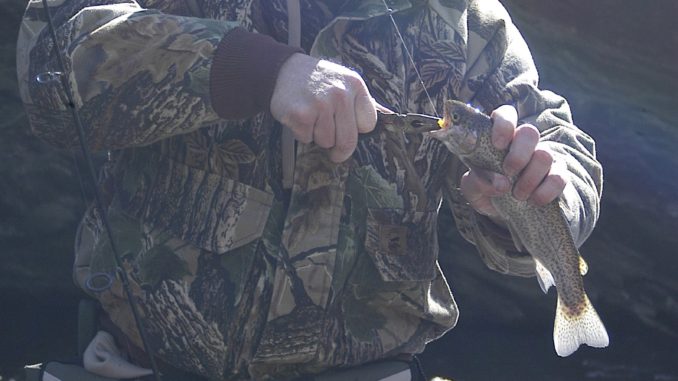
Ken Dielke watched his spinning rod bend and jump as he battled a 14-inch-long brook trout at an Ashe County stream last April.
“We come up here each year on opening day because the fishing is so good,” he said. “We catch rainbows, browns and brookies. It reminds me of Montana.”
Dielke once fished for trout at the Flathead Indian Reservation in the Treasure State before moving south a few years ago. The Charlotte resident now can be found at Ashe County streams with several of his friends each April opening day.
North Carolina’s hatchery-supported trout season opens 7 a.m., April 3, 2010 for almost 1,000 streams in 25 western counties. The season runs until 30 minutes after sunset on Feb. 28, 2011.
While fishing hatchery-supported trout waters, anglers may keep a maximum of seven trout per day, with no minimum-size limits or bait restrictions. Hatchery-supported trout waters, marked by green-and-white signs, are stocked from March until August, many of them monthly. Some heavily-pressured streams are stocked more often.
During 2010, WRC workers will stock nearly 864,000 trout taken from four state hatcheries, with 96 percent averaging 10 inches in length and the other 4 percent at least 14 inches or longer. The WRC stocks hatchery-supported streams a week before the season opens. Because these fish are altered to be sterile while reared at hatcheries, they can’t interbreed with native trout, so there’s no danger of gene mixing, according to WRC biologists.
Because hatchery trout are usually unwary of lures, they readily bite artificial lures, which brings hundreds of trout anglers to the mountains each opening day.
Most anglers used ultra-light spinning rods and reels. One of the favorite hatchery-supported stream lures is a 3-inch-long artificial worm in an assortment of colors (pink, yellow, red, chartreuse, orange). Standard rigs use one or two split shots pinched on the line 18 inches above the lure and a single hook. Anglers also used fly tackle.
While hatchery-supported waters are open to public fishing, many of those miles are privately owned.
“Anglers need to know that fishing opportunities on many hatchery-supported streams are available only through the continued support of landowners,” said Doug Besler, Mountain Region supervisor for the Division of Inland Fisheries. “For this reason, we want to remind anglers to respect the land they’re using and remember that access can be taken away if landowners feel their land is being abused.”
Mountain trout waters are classified as hatchery-supported, wild trout, wild trout natural bait, delayed-harvest, catch-and-release artificial lures only, catch-and-release-artificial-flies only, special regulation and undesignated.
Each type of stream has special lure and bait restrictions along with specified creel limits. Check the 2009-10 Regulations Digest (page 21) or visit the WRC web site at http://www.ncwildlife.org/Regs/2009_10/2009_10_Mountain_Trout.pdf for N.C. trout stream regulations. For stream stocking schedules, visit http://www.ncwildlife.org/Fishing/Fish_Seasons_Stocking.htm.
The WRC defines artificial lures as those that haven’t been treated with any substance that attracts fish by taste or smell. Natural bait is “any living or dead organism (plant or animal) or parts or prepared substances designed to attract fish by taste or smell.”





Be the first to comment